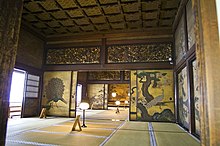Shoin-zukuri

Shoin-zukuri (書院造) is a style of Japanese residential architecture used in the mansions of the military, temple guest halls, and Zen abbot's quarters of the Azuchi-Momoyama (1568-1600) and Edo periods (1600-1868). It forms the basis of today's traditional-style Japanese house. Characteristics of the shoin-zukuri development were the incorporation of square posts and floors completely covered with tatami.[1] The style takes its name from the shoin, a term that originally meant a study and a place for lectures on the sūtra within a temple, but which later came to mean just a drawing room or study.[2]
History


The foundations for the design of today's traditional Japanese residential houses with tatami floors were established in the late Muromachi period and refined during the ensuing Momoyama period.[3][4] Shoin-zukuri, a new architectural style influenced by Zen Buddhism, developed during that time from the shinden-zukuri of the earlier Heian period's palaces and the subsequent residential style favored by the warrior class during the Kamakura period.[3][5][6] The term shoin (書院), meaning study or drawing room has been used to denote reception rooms in residences of the military elite as well as study rooms at monasteries.[3][7] A shoin has a core area surrounded by aisles, and smaller areas separated by fusuma sliding doors, or shōji partitions constructed of paper on a wooden frame or wooden equivalents, mairado (舞良戸) and sugido (杉戸).[5] The main reception room is characterized by specific features: a recessed alcove (tokonoma); staggered shelves; built-in desks; and ornate sliding doors.[3][5] Generally the reception room is covered with wall-to-wall tatami, has square beveled pillars, a coved and/or coffered ceiling, and wooden shutters protecting the area from rain (雨戸, amado).[3][5] The entrance hall (genkan) emerged as an element of residential architecture during the Momoyama period.[5] The oldest extant shoin style building is the Tōgu-dō at Ginkaku-ji dating from 1485. Other representative examples of early shoin style, also called shuden, include two guest halls at Mii-dera.[8] In the early Edo period, shoin-zukuri reached its peak and spread beyond the residences of the military elite.[4] The more formal shoin-style of this period is apparent in the characteristics of Ninomaru Palace at Nijō Castle as well as the shoin at Nishi Hongan-ji (see photos above).[4][9]
The simpler style used in the architecture of tea houses for the tea ceremony developed in parallel with shoin-zukuri. In the 16th century Sen no Rikyū established dedicated "grass hut" (草庵, sōan) style teahouses characterized by their small size of typically two to eight mat, the use of natural materials, and rustic appearance.[10] This teahouse style, exemplified by the Joan and Taian teahouses, was influenced by Japanese farmhouse style and the shoin style[11] featuring tatami matted floors, recessed alcoves (tokonoma) and one or more ante chambers for preparations.[11]
Sukiya-zukuri
By the beginning of the Edo period, the features of the shoin and the teahouse styles began to blend.[12] The result was an informal version of the shoin style called sukiya-zukuri (数寄屋造).[13][14] The sukiya-zukuri style has a characteristic decorative alcove and shelf, and utilizes woods such as cedar, pine, hemlock, bamboo, and cypress, often with rough surfaces including the bark.[14] Compared to the shoin style's, roof eaves in the sukiya style bend downward.[13] While the shoin style was suitable for ceremonial architecture, it became too imposing for residential buildings. Consequently, the less formal sukiya style was used for the mansions of the aristocracy and samurai after the beginning of the Edo period.[14][15]
See also
Notes
- ^ Kodansha Encyclopedia of Japan, entry for "shoin-zukuri".
- ^ Iwanami Kōjien (広辞苑) Japanese dictionary, 6th Edition (2008), DVD version
- ^ a b c d e Young & Young 2007, p. 80
- ^ a b c Young & Young 2007, p. 81
- ^ a b c d e "shoinzukuri". JAANUS – Japanese Architecture and Art Net User System. Retrieved 2009-11-17.
- ^ Young & Young 2007, p. 79
- ^ "shoin". JAANUS – Japanese Architecture and Art Net User System. Retrieved 2009-11-17.
- ^ Nishi & Hozumi 1996, p. 76
- ^ Nishi & Hozumi 1996, p. 75
- ^ "souan". JAANUS – Japanese Architecture and Art Net User System. Retrieved 2009-11-17.
- ^ a b Young, Young & Yew 2004, p. 63
- ^ Young & Young 2007, p. 90
- ^ a b Young, Young & Yew 2004, p. 100
- ^ a b c "sukiyazukuri". JAANUS – Japanese Architecture and Art Net User System. Retrieved 2009-11-17.
- ^ Nishi & Hozumi 1996, p. 78
References
- Nishi, Kazuo; Hozumi, Kazuo (1996) [1983]. What is Japanese architecture? (illustrated ed.). Kodansha International. ISBN 4-7700-1992-0. Retrieved 2009-11-11.
{{cite book}}: CS1 maint: ref duplicates default (link) - Young, David; Young, Michiko (2007) [2004]. The art of Japanese architecture. Architecture and Interior Design (illustrated, revised ed.). Tuttle Publishing. ISBN 0-8048-3838-0. Retrieved 2009-11-11.
{{cite book}}: CS1 maint: ref duplicates default (link)

